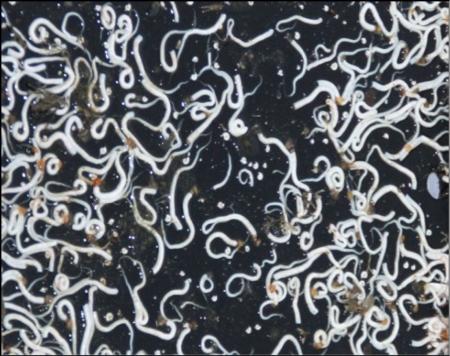Tube worms
-
Scientific Name
Hydroides spp. (H. elegans, & H. gracilis) - Visit ITIS for full scientific classification.
-
Description
 Hydroides spp. Photo by Carrie Culver © 2008 Regents, University of California.
Hydroides spp. Photo by Carrie Culver © 2008 Regents, University of California.- Small, tube-dwelling, marine worms.
- Attach to hard surfaces by forming long, thick, irregularly coiled, white calcareous (chalk-like) tubes.
- When viewed under a microscope, body segments and feather-like tentacles can be seen.
-
Habitat
- Occur in subtidal and low intertidal areas.
- Abundant in marinas, docks, and rocky environments with many hard surfaces.
- Found on a variety of natural and man-made surfaces including: woody debris, shells of other animals, oyster reefs, rocky reefs, pier pilings, vessel hulls, intake lines, canals, etc.
-
Invasion Pathways and Distribution
- Spread by attaching to vessel hulls, from which larvae swim to settle on surfaces in marinas.
- One species, Hydroides elegans, is originally described from Sydney, Australia.
- The exact native origin is assumed to be somewhere in the Indo-Pacific.
- The origin of a close relative, H. gracilis, is Pacific Grove, California.
- Both are found worldwide, including all along the California coast.
- See NEMESIS for a distribution map.
-
Life History
- Filter-feeders; use feather-like gill tentacles to capture particles in the water.
- Reproduce sexually by releasing sperm and eggs into the water, where they unite to form swimming larvae
-
Impacts
- Hydroides elegans is a well-known, dominant fouling species with the potential to outcompete native species for space and food.
- The chalky tubes form heavy crusts on boat hulls.
- This fouling growth roughens the hull’s surface, creating friction or “drag” that slows sailboats and increases fuel consumption for powerboats.
- Tolerant of copper in antifouling paint, and are very difficult to remove.
-
References and Useful Links
For references by category and links to other useful AIS sites see our LEARN MORE page.

